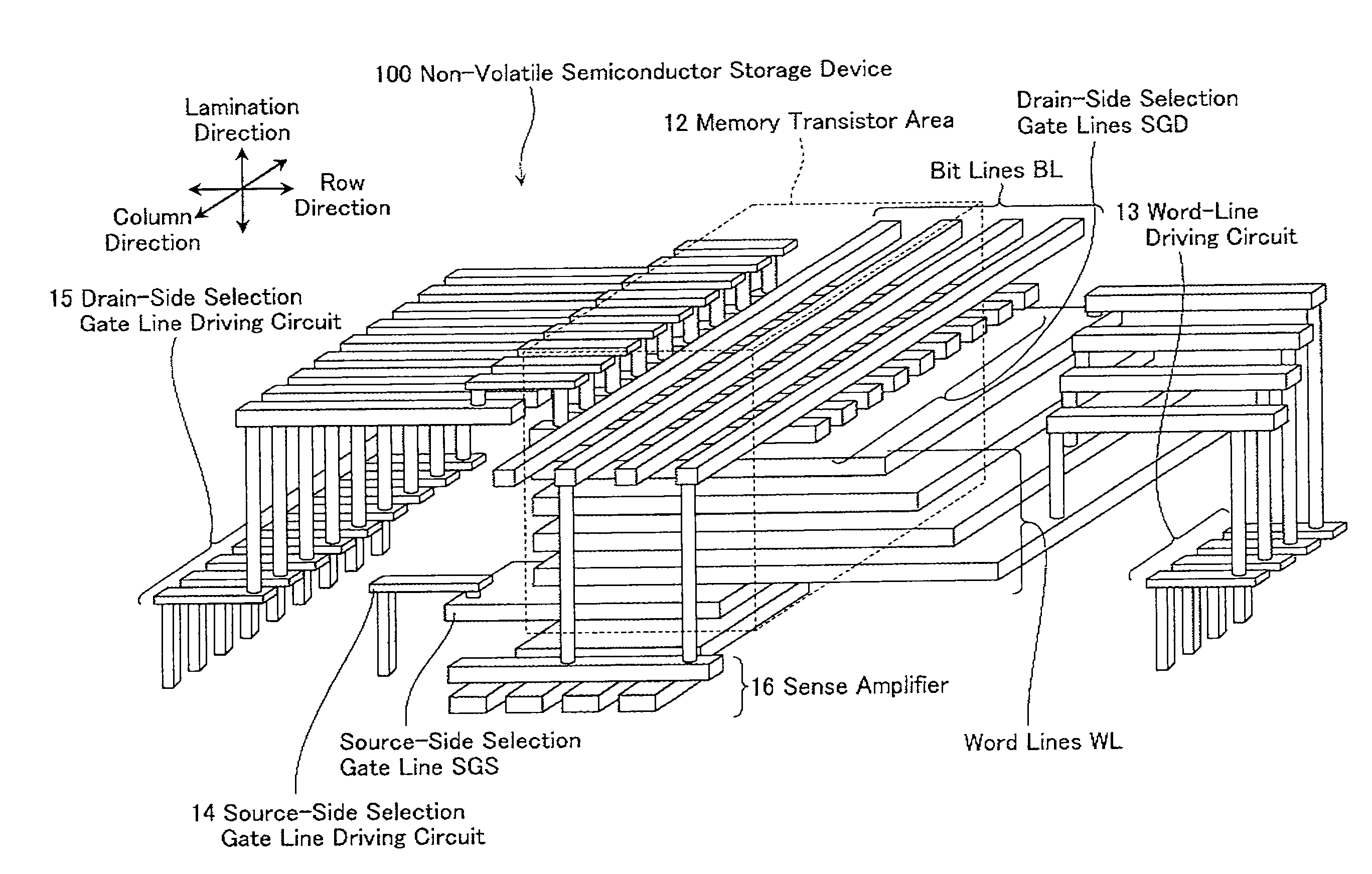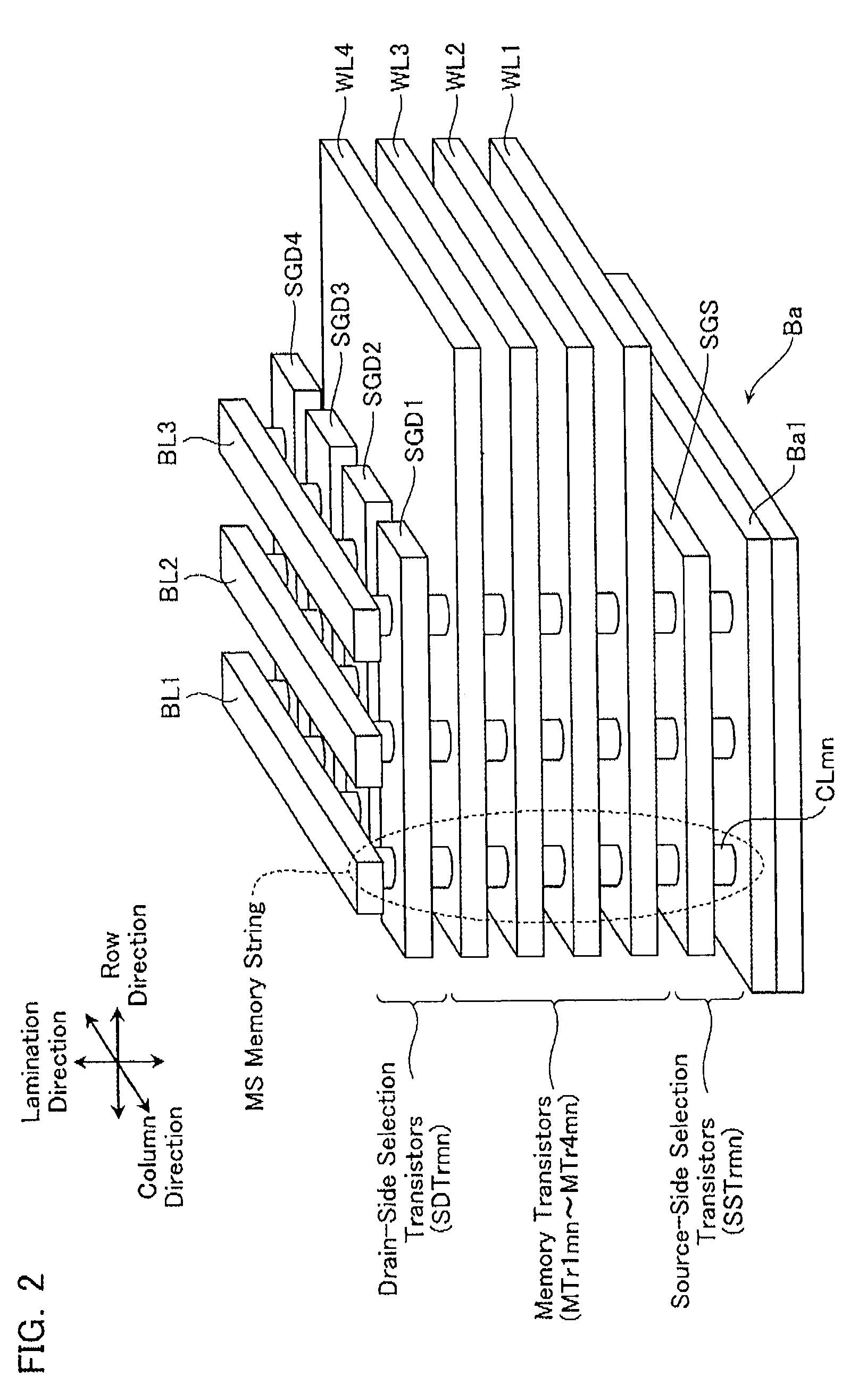Non-volatile semiconductor storage device and method of manufacturing the same
a non-volatile, semiconductor technology, applied in semiconductor devices, instruments, electrical equipment, etc., can solve the problems of difficult to meet the requirements of such refinement, and inability to meet the requirements of euv exposure devices. , to achieve the limit of physical improvement, such as the breakdown voltage between devices, the effect of achieving the limi
- Summary
- Abstract
- Description
- Claims
- Application Information
AI Technical Summary
Benefits of technology
Problems solved by technology
Method used
Image
Examples
first embodiment
[0065]Configuration of Non-Volatile Semiconductor Storage Device 100 in First Embodiment
[0066]FIG. 1 schematically illustrates a non-volatile semiconductor storage device 100 according to a first embodiment of the present invention. As illustrated in FIG. 1, the non-volatile semiconductor storage device 100 according to the first embodiment mainly comprises: a memory transistor area 12; a word-line driving circuit 13; a source-side selection gate line (SGS) driving circuit 14; a drain-side selection gate line (SGD) driving circuit 15; and a sense amplifier 16. The memory transistor area 12 has memory transistors for storing data. The word-line driving circuit 13 controls voltage applied to word lines WL. The source-side selection gate line (SGS) driving circuit 14 controls voltage applied to the source-side selection gate line SGS. The drain-side selection gate line (SGD) driving circuit 15 controls voltage applied to drain-side selection gate lines (SGD). The sense amplifier 16 amp...
second embodiment
[0135]Specific Configuration of Non-Volatile Semiconductor Storage Device in Second Embodiment
[0136]Referring now to FIG. 21, a specific configuration of a non-volatile semiconductor storage device according to a second embodiment of the present invention will be described below. Note that the same reference numerals represent the same components as the first embodiment and description thereof will be omitted in the second embodiment.
[0137]As illustrated in FIG. 21, the non-volatile semiconductor storage device according to the second embodiment has a memory transistor layer 30a different from the first embodiment. Unlike the first embodiment, the memory transistor layer 30a has a memory hole 35′ with its sidewall formed in a concavo-convex pattern.
[0138]The sidewalls of first to fifth insulation layers between word lines 31a′ to 31e′ facing the memory hole 35′ are formed to protrude inward as compared with the sidewalls of first to fourth word-line conductive layers 32a′ to 32d′ fa...
third embodiment
[0143]Specific Configuration of Non-Volatile Semiconductor Storage Device in Third Embodiment
[0144]Referring now to FIG. 22, a specific configuration of a non-volatile semiconductor storage device according to a third embodiment of the present invention will be described below. Note that the same reference numerals represent the same components as the first embodiment and description thereof will be omitted in the third embodiment.
[0145]As illustrated in FIG. 22, the non-volatile semiconductor storage device according to the third embodiment has a memory transistor layer 30b different from the first and second embodiments. The memory transistor layer 30b has a memory hole 35″ with its sidewall formed in a concavo-convex pattern at positions different from the second embodiment.
[0146]The sidewalls of first to fifth insulation layers between word lines 31a″ to 31e″ facing the memory hole 35″ are formed to be caved outward as compared with the sidewalls of first to fourth word-line con...
PUM
 Login to View More
Login to View More Abstract
Description
Claims
Application Information
 Login to View More
Login to View More - R&D
- Intellectual Property
- Life Sciences
- Materials
- Tech Scout
- Unparalleled Data Quality
- Higher Quality Content
- 60% Fewer Hallucinations
Browse by: Latest US Patents, China's latest patents, Technical Efficacy Thesaurus, Application Domain, Technology Topic, Popular Technical Reports.
© 2025 PatSnap. All rights reserved.Legal|Privacy policy|Modern Slavery Act Transparency Statement|Sitemap|About US| Contact US: help@patsnap.com



